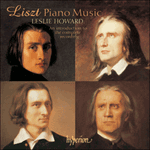The piano versions of eleven of the twelve
Chorales, better known, at least in catalogues, for they are never performed, as choral works, were also published for the first time in the New Liszt Edition in 1980. They are obviously intended for private performance and represent the simplest piano-writing to come from Liszt’s pen. As so often in these circumstances, Liszt has supplied copious fingering! In private, one may repeat the music as many times as the verses of the hymn allow. Here, only the structural repeated sections of chorale melodies are observed, in numbers 7 and 11. It will be seen immediately that the music to the sixth and eighth chorales is identical with the equivalent movements in
Via Crucis—and it is not clear which version came first, although the introductions and codas seem to indicate that these chorales, at least, succeeded the longer work. Some of these chorales are Lutheran, others based on plainsong. The New Liszt Edition gives a thorough outline of the sources of melodies and texts for those interested. There is no clear order of these pieces in the sources, so the NLE presents them in alphabetical order, which is adopted on this recording. The titles may be translated:
Hail blessed Cross;
Jesus Christ (The five wounds);
My soul doth magnify the Lord;
Now thank we all our God;
Now all the woods are silent;
O sacred head sore wounded;
O Lamb of God;
O Sadness (on Good Friday);
The Royal banners (a different setting from the one in Via Crucis);
What God does is done well (different from the version in the ‘Weinen, Klagen’ Variations) and
If thou but suffer God to guide thee. There are many instances of very personal harmonic colourings in Liszt’s versions—from which many a hymn book might benefit!
from notes by Leslie Howard © 1990
Les versions pour piano de onze des douze
Chorals, mieux connues—du moins dans les catalogues, car elles ne sont jamais exécutées—comme œuvres chorales, furent aussi publiées pour la première fois dans la Nouvelle Edition Liszt en 1980. Elles sont à l’évidence conçues pour être exécutées en privé et présentent la plus simple écriture pianistique qui ait jamais coulé de la plume de Liszt. Comme si souvent dans ces circonstances, Liszt a fourni d’amples indications de doigté! En privé, on peut reprendre la musique autant de fois que le permettent les strophes de l’hymne. Ici, seules sont observées les reprises structurales des mélodies chorales, dans les numéros 7 et 11. On voit tout de suite que la musique des sixième et huitième chorals est identique aux mouvements équivalents de
Via Crucis. On ignore quelle version précède l’autre, mais d’après les introductions et codas il semblerait que ces chorals, au moins, sont postérieurs à l’œuvre plus longue. Certains de ces chorals sont luthériens, d’autres basés sur le plain-chant. La Nouvelle Edition Liszt donne une liste complète des sources des textes et des mélodies pour ceux que cela intéresse. Ces sources ne fournissent pas d’ordre évident pour ces pièces, et la NEL les présente par ordre alphabétique, également adopté pour cet enregistrement. Les titres peuvent être traduits comme suit:
Salut sainte croix;
Jésus-Christ (Les cinq blessures);
Mon âme glorifie le Seigneur;
Remercions notre Dieu;
Maintenant les bois sont silencieux;
Ô sainte tête blessée;
Ô Agneau de Dieu;
Ô Tristesse (le vendredi saint);
Les étendards royaux (arrangement différent de celui de
Via Crucis);
Ce que Dieu fait est bien fait (différent de la version des variations sur «Weinen, Klagen») et
Si tu laisses Dieu te guider. Il y a de nombreux exemples de colorations harmoniques très personnelles dans les versions de Liszt—dont bénéficierait plus d’un recueil de cantiques!
extrait des notes rédigées par Leslie Howard © 1990
Français: Hypérion
Die Klavierfassungen von elf der zwölf
Choräle, die zumindest aus den Katalogen (sie werden niemals aufgeführt) als Chorwerke besser bekannt sind, wurden ebenfalls 1980 zum ersten Mal in der Neuen Ausgabe sämtlicher Werke veröffentlicht. Sie sind offensichtlich zur privaten Darbietung gedacht und stellen die schlichtesten Klavierkompositionen dar, die je aus Liszts Feder geflossen sind. Wie so oft unter ähnlichen Umständen hat Liszt umfassende Angaben zum Fingersatz mitgeliefert! Im privaten Kreise darf die Musik soviele Male wiederholt werden, wie es die Strophen des Liedes erlauben. Hier wurden nur im 7. und 11. Stück strukturbedingte Wiederholungen der Choralmelodien ausgeführt. Auf den ersten Blick ist zu erkennen, daß die Musik des 6. und 8. Chorals mit den entsprechenden Sätzen in
Via crucis identisch ist—und es ist nicht klar, welche Version als erste entstand. Allerdings scheinen die Introduktionen und Codas darauf hinzudeuten, daß zumindest die genannten Choräle Nachfolger des längeren Werks sind. Einige der Choräle sind lutherischer Herkunft, andere beruhen auf älteren einstimmigen Kirchenliedern. Für alle Interessierten gibt die Neue Liszt-Ausgabe einen ausführlichen Abriß der Quellen von Melodie und Text. Aus den Quellen läßt sich keine eindeutige Reihenfolge für die einzelnen Stücke entnehmen, darum listet die Ausgabe sämtlicher Werke sie alphabetisch auf. Die vorliegende Aufnahme übernimmt diese Reihenfolge. In Liszts Bearbeitungen finden sich zahlreiche Beispiele einer zutiefst persönlichen harmonischen Gestaltung—von denen manch ein Gesangbuch profitieren könnte!
aus dem Begleittext von Leslie Howard © 1990
Deutsch: Anne Steeb/Bernd Müller


 Liszt: Complete Piano Music
Liszt: Complete Piano Music Liszt: Piano Music
Liszt: Piano Music
